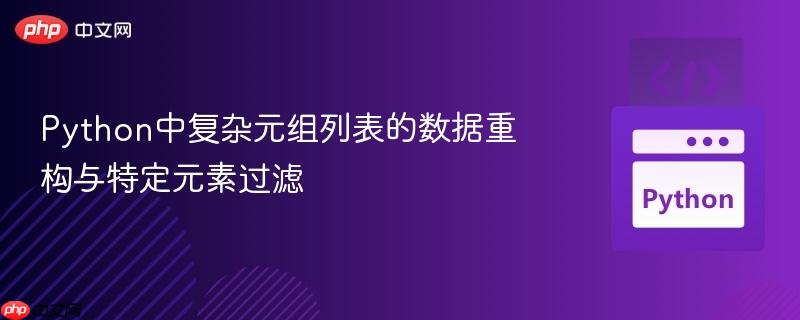
本教程详细阐述如何在python中对包含嵌套元组的复杂列表进行数据重构。核心内容包括:遍历并解包外层元组,高效过滤掉内层元组中的特定元素(例如数值0),以及将原始整数元素重新定位并与过滤后的数据合并,最终生成一个扁平化且结构规范的元组列表,以满足特定的数据处理需求。
在Python数据处理中,我们经常需要对复杂或嵌套的数据结构进行转换,以适应后续的分析、存储或API接口需求。这种转换可能涉及改变数据类型、调整元素顺序、过滤特定值等操作。本教程将聚焦于一个具体的场景:将一个包含整数和嵌套元组的列表,转换成一个扁平化的元组列表,同时移除内层元组中的特定元素并调整元素顺序。
假设我们拥有以下形式的原始数据,它是一个由元组组成的列表,每个外层元组包含一个整数和另一个嵌套元组:
原始数据结构示例:
list_of_tuples_of_tuples = [
(5, ('RoadAttributes', 'egoInformationCompex', 0, 'speedlimit', 'id')),
(5, ('RoadAttributes', 'egoInformationCompex', 0, 'speedlimit', 'distanceStdDev'))
]在这个结构中:
立即学习“Python免费学习笔记(深入)”;
我们的目标是将这种复杂结构转换为一个更扁平、更规范的元组列表,具体要求如下:
目标数据结构示例:
[
('RoadAttributes', 'egoInformationCompex', 'speedlimit', 'id', 5),
('RoadAttributes', 'egoInformationCompex', 'speedlimit', 'distanceStdDev', 5)
]通过对比原始数据和目标数据,我们可以明确以下转换需求:
实现上述转换需要结合Python的迭代、条件过滤和元组拼接等操作。我们将通过分步解析来构建解决方案。
首先,我们需要遍历 list_of_tuples_of_tuples。由于每个元素都是一个包含两个子元素的元组,我们可以利用Python的元组解包特性,在循环中直接获取这两个部分。
res = [] # 用于存储最终结果的列表
for integer_val, inner_tuple in list_of_tuples_of_tuples:
# 在每次迭代中:
# integer_val 将是外层元组的第一个元素(例如 5)
# inner_tuple 将是外层元组的第二个元素(例如 ('RoadAttributes', 'egoInformationCompex', 0, 'speedlimit', 'id'))
# 接下来的操作将针对这两个解包出的变量进行
pass # 占位符,后续步骤将在此处填充代码针对解包出的 inner_tuple,我们需要过滤掉其中值为 0 的元素。这可以通过生成器表达式结合条件判断高效完成。
# 承接上一步的循环内部
# ...
# 使用生成器表达式过滤掉 inner_tuple 中的 '0'
filtered_inner_elements = (item for item in inner_tuple if item != 0)
# 将生成器表达式的结果转换为元组
filtered_inner_tuple = tuple(filtered_inner_elements)
# 示例:
# 如果 inner_tuple 是 ('RoadAttributes', 'egoInformationCompex', 0, 'speedlimit', 'id')
# 那么 filtered_inner_tuple 将是 ('RoadAttributes', 'egoInformationCompex', 'speedlimit', 'id')
# ...现在我们有了过滤后的 filtered_inner_tuple 和原始的 integer_val。根据目标结构,我们需要将 integer_val 放置在 filtered_inner_tuple 的末尾。在Python中,元组只能与元组进行拼接 (+ 操作)。因此,需要将 integer_val 转换为一个单元素元组。
# 承接上一步的循环内部
# ...
# 将整数转换为单元素元组,以便与另一个元组拼接
integer_as_tuple = (integer_val,) # 注意逗号,它表示这是一个元组
# 拼接元组,将整数放在末尾
combined_tuple = filtered_inner_tuple + integer_as_tuple
# 示例:
# 如果 filtered_inner_tuple 是 ('RoadAttributes', 'egoInformationCompex', 'speedlimit', 'id')
# 并且 integer_as_tuple 是 (5,)
# 那么 combined_tuple 将是 ('RoadAttributes', 'egoInformationCompex', 'speedlimit', 'id', 5)
# ...最后一步是将每次循环生成的 combined_tuple 添加到我们预先定义的结果列表 res 中。
# 承接上一步的循环内部
# ...
res.append(combined_tuple)将以上所有步骤整合,得到完整的解决方案代码:
list_of_tuples_of_tuples = [
(5, ('RoadAttributes', 'egoInformationCompex', 0, 'speedlimit', 'id')),
(5, ('RoadAttributes', 'egoInformationCompex', 0, 'speedlimit', 'distanceStdDev'))
]
res = [] # 初始化结果列表
for integer_val, inner_tuple in list_of_tuples_of_tuples:
# 1. 过滤内层元组中的 '0'
# 使用生成器表达式以提高内存效率,然后转换为元组
filtered_inner_elements = (item for item in inner_tuple if item != 0)
filtered_inner_tuple = tuple(filtered_inner_elements)
# 2. 将原始整数转换为单元素元组,以便与另一个元组拼接
integer_as_tuple = (integer_val,)
# 3. 拼接元组,将整数放在末尾,完成重排和扁平化
combined_tuple = filtered_inner_tuple + integer_as_tuple
# 4. 将新生成的元组添加到结果列表中
res.append(combined_tuple)
print(res)运行结果:
[('RoadAttributes', 'egoInformationCompex', 'speedlimit', 'id', 5), ('RoadAttributes', 'egoInformationCompex', 'speedlimit', 'distanceStdDev', 5)]这与我们预期的目标数据结构完全一致。
本教程详细展示了如何通过迭代、条件过滤和元组拼接,将复杂的嵌套元组列表转换为更扁平、更规范的数据结构。掌握这种数据重构模式对于Python开发者处理和重塑异构数据至关重要。通过理解和应用这些基本操作,开发者可以更有效地组织、清洗和利用数据,以满足各种复杂的数据处理需求。
以上就是Python中复杂元组列表的数据重构与特定元素过滤的详细内容,更多请关注php中文网其它相关文章!

每个人都需要一台速度更快、更稳定的 PC。随着时间的推移,垃圾文件、旧注册表数据和不必要的后台进程会占用资源并降低性能。幸运的是,许多工具可以让 Windows 保持平稳运行。

Copyright 2014-2025 https://www.php.cn/ All Rights Reserved | php.cn | 湘ICP备2023035733号